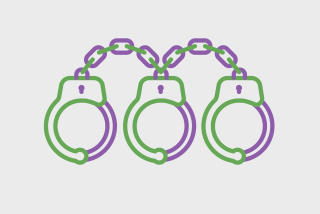Panel OKs Bill Aimed at Gun-Related Crimes
- Share via
SACRAMENTO — After exhortations from Gov. Pete Wilson and Atty. Gen. Dan Lungren, a state Senate committee narrowly approved legislation Tuesday to dramatically increase prison sentences for felons who carry or use guns.
In the Assembly, meanwhile, legislation to ban the manufacture and sale of cheap handguns won approval in the Public Safety Committee.
But it was the measure to toughen prison terms for felons who carry or use guns that received the most attention Tuesday.
The bill is the latest anti-crime idea advanced by Mike Reynolds, the Fresno photographer who sponsored the 1994 three-strikes initiative after his daughter, Kimber, was slain in a robbery outside a Fresno restaurant.
Like the three-strikes law that increases sentences for repeat felons, Reynolds’ new measure carries a catchy title: “10-20-Life,” referring to the number of additional years in prison that would be added to sentences of felons who carry or use guns during their crimes.
And as he did with three strikes, Reynolds is vowing to push the measure as a statewide ballot initiative if the Legislature fails to approve it--something that Lungren and Wilson would welcome because it would give Republicans a campaign issue in 1998.
“Any attempt to water it down . . . will be an insult to every Californian who has been a victim of a gun-related crime,” Wilson said Tuesday, shortly before the Senate Public Safety Committee took up the bill (AB 4) by Assemblyman Tom Bordonaro (R-Paso Robles).
“This is the most effective, the toughest gun abuse law in the country,” Lungren added, warning the committee against doing “a Tyson on it--trying to take a solid piece out it” by weakening it with amendments.
The measure, which had been stalled for much of the day, ended up winning committee approval with the minimum five votes necessary for passage. Only a minor amendment was added.
As he spoke of the need for the bill, Bordonaro told committee members that his sister, Sandra Peters, was shot and killed in 1972 outside Carmel by a drug dealer.
“I never blamed the gun. I blame the guy who made the decision,” Bordonaro said in an interview after the bill was approved. The bill now goes to the Senate Appropriations Committee.
Among the Democratic committee members who supported the measure was Sen. Richard Polanco (D-Los Angeles). Polanco voted for it after an Assembly committee approved his bill (SB 500) to ban the manufacture and sale of cheap handguns. It now goes to the Assembly Appropriations Committee.
“I see it as a comprehensive approach,” Polanco said. “You deal with the Saturday night specials and ban them, and you deal with those [criminals] who are using the guns.”
Although Wilson is eager to sign the Reynolds proposal into law, the Republican governor has given no indication whether he would sign the bill to ban the sale of cheap handguns, 80% of which are manufactured in California and are the overwhelming gun of choice for criminals.
Currently, felons who fire guns when committing a crime receive an additional three, four or 10 years in prison, depending on the circumstances.
Under Reynolds’ proposal, judges would be required to add 10 years to prison terms for felons who carry a gun during a crime, plus whatever sentence they would receive for the crime itself.
If the criminal fires the gun during the crime, the judge would be required to add 20 years to the prison sentence. If a crime victim is injured by gunfire, the criminal would receive a mandatory sentence of 25 years to life in prison, on top of the sentence for the underlying crime.
“Its simplicity is its strength,” Reynolds said, contending that criminals would easily understand the consequences of using guns, as repeat felons know they face sentences of 25 years to life if they are convicted of a third felony.
Democrats opposing the measure cite estimates that the bill would result in major prison population increases, requiring more prison construction and costing the state tens of millions of dollars more annually to operate them.
More to Read
Get the L.A. Times Politics newsletter
Deeply reported insights into legislation, politics and policy from Sacramento, Washington and beyond. In your inbox twice per week.
You may occasionally receive promotional content from the Los Angeles Times.










